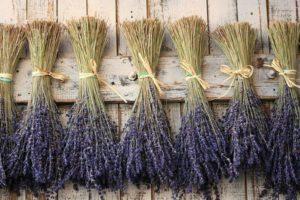Planting, growing and caring for peonies in the open field, agricultural technology
Since ancient times, beautiful spring peonies adorn flower beds, planting and caring for this lush shrub requires certain skills. The plant prefers sunny areas and does not tolerate swampy soil. New varieties of peonies with a longer flowering period have been developed and do not require support. Usually peonies are grown for cutting, but they only stand in water for 4 days. It is better to leave the plant in the flowerbed and admire its exquisite appearance.
Description and features
Peonies are hard to miss in a flower bed, because huge, bright, fragrant flowers are the main decoration of the flower garden. This rhizome plant grows in one place for several years, blooms in late spring. Its erect stems 45-100 centimeters high, together with foliage, form a tall, lush bush.
Leaves are large, alternate, trifoliate or pinnate. Flowers - apical, single, large, 10-25 centimeters in diameter. They are simple or terry. The color of the flowers is varied, from milky white to bright purple. The fruit is a multileaf with seeds inside.
Peony is a member of the Peony family. The plant got its name from Greek myth. The healed Hades thanked his savior and did not let him die, turning him into an exquisite flower before his death.
How to plant in open ground
Peony is a perennial crop that can grow in the same place for several decades. Before planting a flower, you need to choose a suitable place for it.

Seat selection
A well-lit area is suitable for culture. The plant can be planted on a mound to allow water to drain from the roots when it rains.
Good lighting
Peony does not grow well in the shade of tall trees and shrubs. In a highly shaded area, the plant may not bloom. The flower bed should be illuminated by direct sunlight for at least 6 hours a day.
Stagnation of moisture is not allowed
Peony is a viable crop that tolerates frost or drought well.There are many dormant buds on its rhizome, which wake up in the spring after winter, but in the ground flooded with water, they all rot, which causes the plant to die.
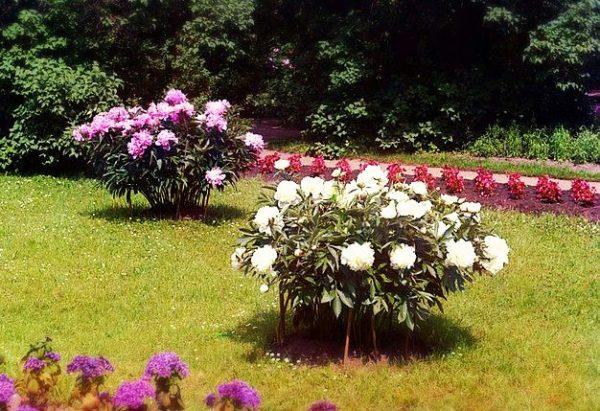
Wind protection
Peonies can be planted near a house or hedge (one meter away). In such places, the bush will be protected from sudden gusts of wind.
Soil requirements
The peony bush does not like peat. It is not recommended to use it as an additive, mulch or winter shelter. Peat has an acidic reaction, and a neutral acidity soil is suitable for a peony culture. Too acidic soil must be limed. For peony bushes, loam or sandy loam, well-drained, fertile soil are suitable. Soil composition: garden, leaf or sod land, humus, sand, clay.
You can add a little ash, superphosphate and ferrous sulfate to the soil.
Timing
Peonies are usually planted in the fall (August-September). At this time, the bushes are dug up and divided. Gardeners who buy planting material in the spring can plant peonies in April. The culture has two periods of regrowth of the suction roots - August-September or April-May. Peonies root only in cool soil (at a temperature of 12 degrees Celsius).
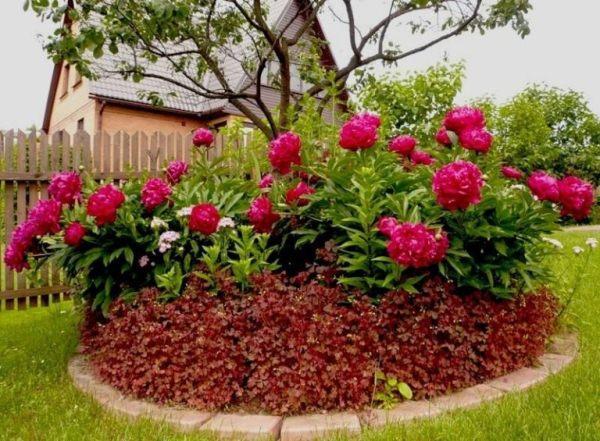
Features of planting in spring
Peonies are usually planted until October. Purchased delenki can be planted in spring. Planting is carried out at the very beginning of April. If the weather is very frosty, you can plant the cut in a pot, put it in a cool place for the germination of suction roots, and transfer it to a flower bed in April-May.
Peonies are transplanted by the transshipment method. If you remove the plant from the pot, you will notice that the entire earthen ball is entangled with white suction roots. In order for the rhizome to grow normally and the peony to develop, you need to transplant the culture to the flower bed. Peonies planted in spring do not take root well.
It is best to plant the cuttings before the buds begin to grow. However, transplanting from a pot to a flower bed along with an earthen lump is not perceived by the plant too painfully.
What you need to know when planting in the fall
It is recommended to plant peonies in August-September so that they have time to take root before frost. By August 15, this plant ends the formation of renewal buds (on the rhizome). New stems will grow from them in the spring. On the twenties, you can dig up a bush intended for propagation and divide its rhizome. Planting material (delenki) can be bought ready-made. Before planting, the rhizome is placed in a Heteroauxin solution for a couple of hours (to stimulate root formation).
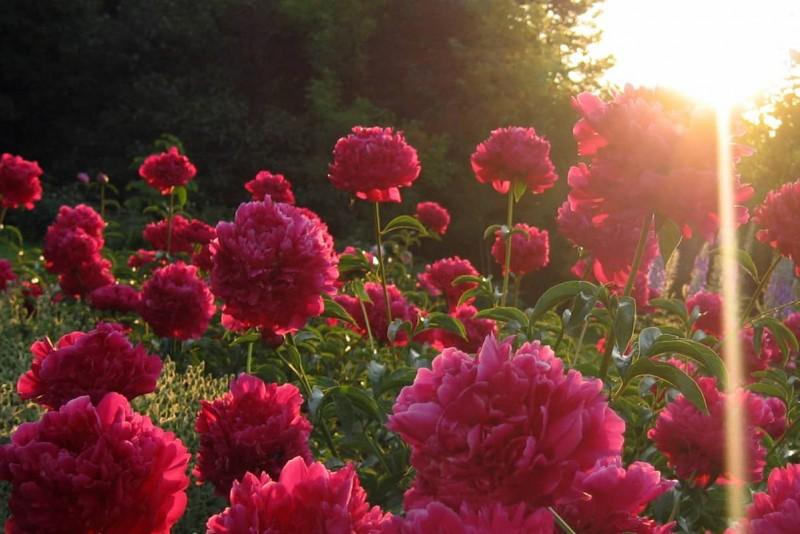
How to choose planting material
A beautiful, lushly blooming peony bush can only be grown from a young plant. It is better not to buy old bushes, because they can bloom several more times, and then wither. It is best to purchase an annual or biennial plant grown in a special nursery. You can take a small cut with 2-3 kidneys.
The root should be young, light, with large buds. You should not buy overdried cuttings with blackened and dried buds.
Bad predecessors
It is better to plant peonies in a flower bed after legumes or lupines. It is undesirable to plant flowers in the place where bushes or perennial plants used to grow. Such crops severely drain the soil, and it takes some time to recover.

Landing scheme
Delenki with kidneys are planted in dug holes. Preparatory planting work is carried out in advance. Two weeks before planting, prepare the soil, fertilize it with rotted humus, potassium, phosphorus, dilute it with sand. They dig a hole 50x50 centimeters in size. Pour on the bottom of the fertilized soil, then a little sand and immerse the cut to a depth of 5 centimeters.
The most important thing when planting is to correctly set the distance from the upper renewal bud to the soil surface. It should be no more than 5 centimeters.To the neighboring flower, you need to leave 1 meter of free area, as the peony shrub grows strongly.
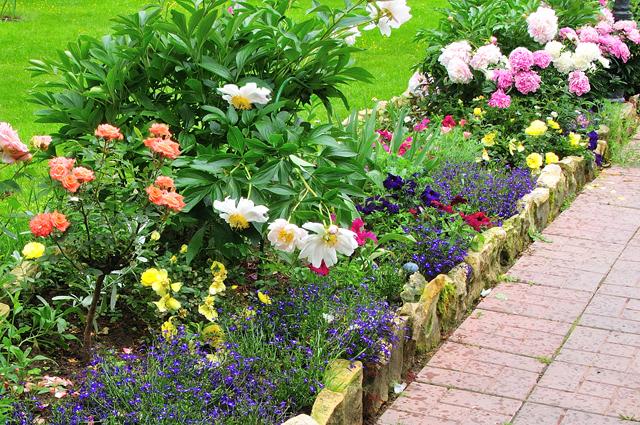
Care and cultivation
Peony bushes will grow for a long time and will delight you with abundant flowering every spring, if properly looked after. After planting, they will bloom only two years later. Before flowering, you do not need to fertilize the soil, but you need to constantly remove weeds from the flower bed and break the soil crust.
Preventive spraying with fungicides
Peonies can get sick in rainy and cool weather. Common diseases are gray rot, rust, and brown spot. Fungal spores are destroyed by fungicides (copper oxychloride, colloidal sulfur, Bordeaux liquid, copper sulfate, Fundazol). The first treatment is carried out in early spring when the shoots sprout. Water the plant itself and the ground near it.

The second and third times, the green foliage is sprayed with a fungicide solution. It is advisable to carry out the processing before or after flowering. An interval of 10-11 days must be observed between sprays. The bush takes 1 liter of solution (5 grams of the drug).
Growth stimulants
For active development, peonies need growth stimulants. In spring and autumn, after planting, the bushes are watered with a Heteroauxin solution. This drug stimulates root formation. To improve the development of stems and leaves, Zircon, Ferovit and Epin are used.
Top dressing
Peony bushes are fed as soon as shoots appear and before flowering. It is best to fertilize the plant with a mullein solution. Fertilizer should be applied to circular holes near the bush. If there is no mullein, the peony can be fed with minerals by dissolving them in water. Even after flowering, until August, the bush needs to be fertilized with phosphorus and potassium.

Foliar
For young plants, it is better to use foliar dressing so that nutrients are absorbed through the leaves. The first is carried out at the time of emergence of sprouts. The peony is fed with urea (5 grams per 1 liter of water). After 10 days, you can spray the plant with this nitrogen fertilizer again.
Subroot
In spring, peony bushes are watered with nitrogen-potassium fertilizers. For one bush, you need to dissolve 10 grams of ammonium nitrate and potassium sulfate in 3 liters of water. During the budding period, the third feeding is performed. For one bush, you need to take 15 grams of potassium sulfate and superphosphate.
Watering
During a drought, the plant must be additionally watered to the full depth of the roots (a bucket of water every 3-4 days). Peony bushes need watering at the time of budding, during flowering and at the end of summer, when flower buds are laid. Peonies are watered every 2-3 days, 3-7 liters of water are poured under the bush.
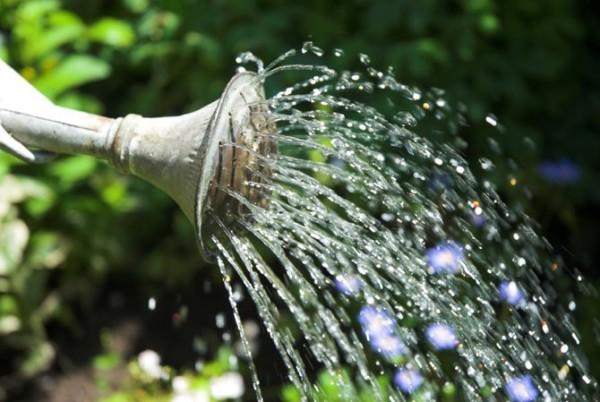
Loosening and weeding
After watering, the ground near the bush can be loosened. Weeds that have appeared must be removed from the flower bed so that they do not take away nutrients.
After flowering
Immediately after flowering, you need to cut the flower heads to the first green leaf and remove them from the flower bed. You do not need to touch the leaves. They should remain in the flowerbed until the very frost. After flowering for 1.5 months, the laying and development of renewal buds (on the rhizome) takes place. Flowering stems will grow from them for the next season.

Transfer
Peony bushes try not to transplant. In one place, they can grow for 10 or more years. If there is a need for a transplant, it is carried out in early spring or autumn. During the autumn transplant, the entire ground part is cut off. The soil is moistened, after which the plant is dug in. Together with the earthen lump, the rhizome is transferred to a new place and immersed in a prepared hole.
Diseases and pests
A crop in rainy and cool weather can contract a fungal infection. Preventive spraying with fungicides (Fundazole, Bordeaux liquid, copper oxychloride) is saved from diseases. Bushes are processed before and after flowering.

Peonies can be attacked by insects. Bronzovka beetles feed on leaves, root nematodes infect roots, and sod ant eats flower petals.Preventive spraying with insecticides (Fitoverm, Actellik, Karbofos) saves from pests.
Botrytis
The disease is caused by a fungus that lives in the soil. Gray mold appears on buds, leaves and stems in damp weather. Too acidic soil and excess nitrogen fertilizers can provoke the disease. For prevention, the soil is treated with lime, and the plants are sprayed with copper-containing preparations in early spring (copper sulfate, Bordeaux mixture).
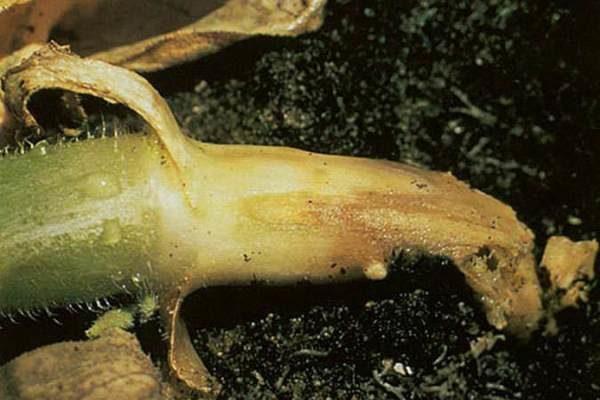
Gray mold
Affects stems, leaves, buds and rhizomes. Brown specks appear on the tips of the leaves, after which they dry out. The base of the stem is covered with a gray bloom, the shoot darkens and breaks. Gray mold can appear on the buds, which, because of it, turn black and dry. Preventive spraying with fungicides is saved from the fungus.
Powdery mildew
Fungal infection affecting leaves in late summer. A white spider web appears on the upper side of the leaves. Spraying with a solution of copper sulfate or soda ash saves from powdery mildew.

Preparation for wintering
Before winter, all stems must be cut to the ground. The aboveground part is cut off only after the first frost, when the stalks fall. Even after the peonies have faded, the foliage is left in the flower bed, since until autumn the outflow of nutrients from the leaves to the roots will take place. Pruning too early can harm the plant. After pruning, the surface above the rhizome can be mulched with dry foliage or sawdust.
Reproduction
Peonies are most often propagated by dividing the rhizome. The best time to breed is April or late August.
Dividing the bush
Closer to autumn, a bush at the age of 3-4 years needs to be dug out of the ground. All stems with leaves are pre-cut. The rhizome is removed from the ground. It needs to be dried, and then divided into divisions. The root is cut with a knife. Each section should have at least 3-5 kidneys. Slices are sprinkled with crushed coal.
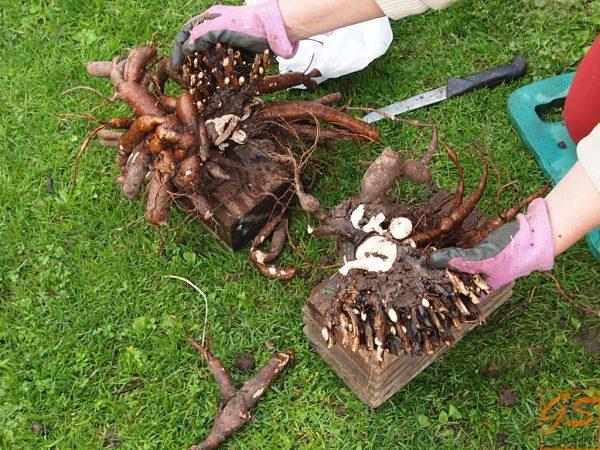
The delenka is kept in a cool room for a couple of days, and then planted in a permanent place. The rhizome can be pretreated with a growth stimulant and fungicide. You can clean the ground near the bush in the spring, cut off a piece of rhizome with a bud and plant it in a new place.
Seed method
This method is rarely used. Peonies grown from seeds will bloom only after 5 years. The seeds are harvested at the end of August. In early September, they are sown on the garden bed and sprinkled with a layer of earth of 5 centimeters. In the spring or a year later, the seeds germinate.
Cuttings
Peonies can be propagated by stem cuttings. In spring, the tops of shoots 10-12 centimeters long are cut off and placed in a jar with Heteroauxin solution. A week later, they are planted in a wet sand-earth mixture and covered with a plastic bottle on top. The plant takes root for 3 weeks, after which it can be transferred to a flower bed.
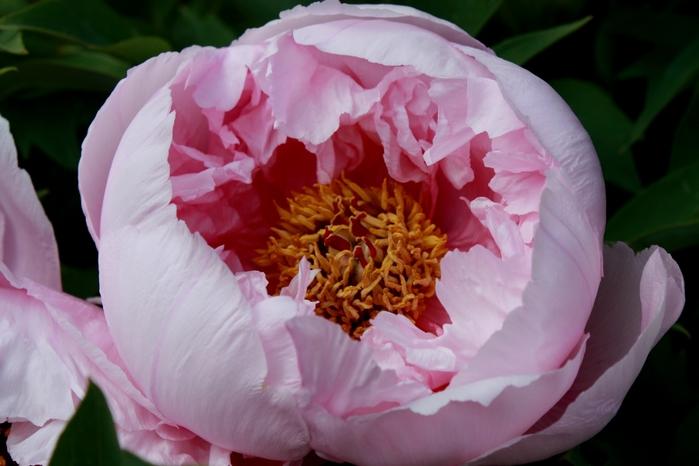
Layers
Mature shrubs aged 5-8 years can be propagated by layering. In the summer, the shoots are pressed to the ground, covered with soil. You can make a small scratch on the stem. By autumn, the roots sprout, after which the layering is cut off from the mother bush and transplanted to a permanent place.
How to plant a tree peony in the garden
Seedlings of tree peonies are usually bought in February-March. At this time, the planting material comes from European and Chinese gardening companies. It is better to store the purchased peony until April in a cool room, and then bury it in a hole in the flower bed. If the buds wake up and begin to grow, you need to plant the rhizome in a pot with a substrate, put it on the window and water it regularly. By the end of May, the planted plant will have suction roots.
The awakened peony is transplanted to a permanent place when the air warms up to 15 degrees Celsius. However, the best time to plant a tree peony is late August, early September.
Why does not it bloom or blooms badly
Gardeners sometimes face unexpected challenges. Regularly caring for peonies, they wait for flowering for several years, which for some reason does not come. It turns out that there are some nuances that you need to pay attention to.
Recessed root planting
The peony will not bloom if the rhizome is deeply deepened during planting. The ideal distance from the kidney to the ground is 5 centimeters. If the root is placed a little deeper, the shoots will grow annually, grow greenery, but never bloom.
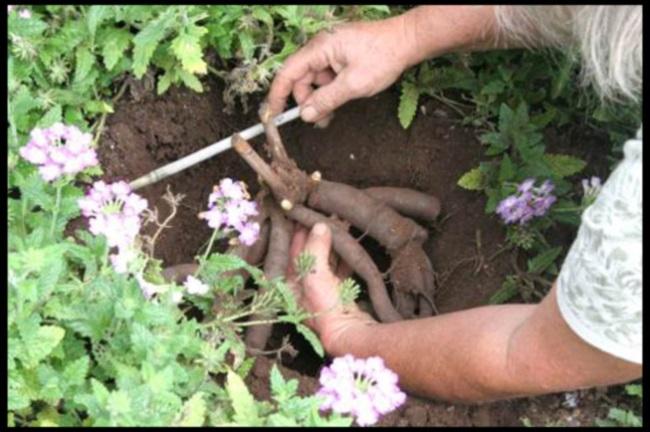
Plant is young
Peonies usually bloom 2-3 years after planting. Late flowering and red varieties can only bloom for 4 years.
The bush is too old
It is not recommended to buy and plant mature bushes. The lifespan of peonies is limited, the old plant stops developing and can be infected with a fungus or a virus.
Diseases
Peonies do not bloom well during illness. Plants, with improper care or in rainy weather, often suffer from gray rot. To prevent disease, peonies are sprayed with copper sulfate or Bordeaux mixture in early spring.

Excessive cropping
If you cut the flowers along with the leaves to the very base, the bush may not bloom next year. The stems with flowers are cut to a third of the length. The leaves are left on the bush until frost.
Problems with agricultural technology
If peonies stopped blooming in spring, it means that they lack nutrients. It is necessary to feed the plants with nitrogen, phosphorus and potassium or complex mineral fertilizers. Peony loves sunlight and moderate watering. If planted in the shade of tall plants and not watered, it will not bud or bloom.
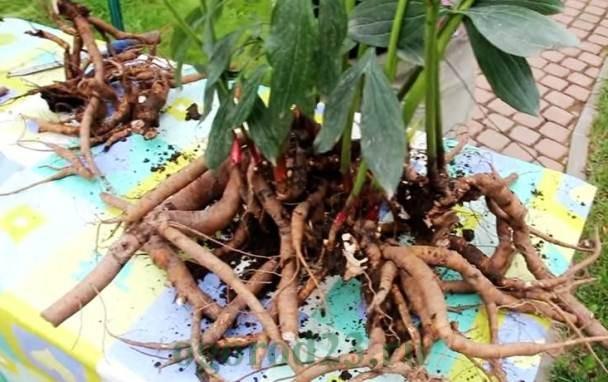
Secrets of growing in the country
Peonies can be grown at their summer cottage. To do this, you need to buy a rhizome with buds and bury it shallowly in a flower bed in August-September. The planted plant will bloom in 2-3 years. Peonies bloom at the end of May. Each flower blooms for 5-10 days, terry varieties bloom longer (up to 15 days). On one bush, there are several dozen buds, which bloom in turn. Peonies can bloom until mid-June.
Removing wilted buds
Withered flowers and buds are immediately cut off without affecting the leaves. If peonies are grown for cutting, then pea-sized side buds are removed. Then the flowers remaining in the center will be more magnificent.
How to cut correctly
The first two years, the buds are completely cut off. At this time, the rhizome is being formed. In the third year, peonies can bloom. The flower is cut in the morning by a third of the stem (40 centimeters), leaving more green leaves on the bush.
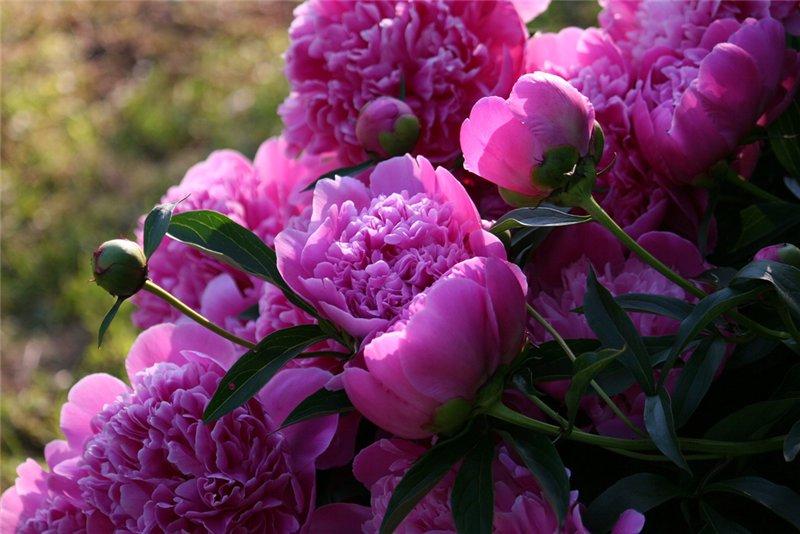
Compliance with the regime of watering and fertilizing
Peonies love the sun, do not tolerate waterlogging. They require regular watering (5-10 liters under a bush once every 3-4 days) and fertilization with urea, potassium sulfate and superphosphate. Top dressing must be applied at least 2 times per season.
Circular support made of plastic and iron
Peonies with large flowers need support. It is made from plastic pipes or iron wire. Rings are installed around the bush, which raise the stems with flowers.
Use in landscape design
New hybrids with small flowers, strong stems and long, abundant flowering are used to decorate the infield and create beautiful compositions. Popular park varieties: Karl Rosenfield, My Love, John Howard Widzel, Dutch Dwarf, Eaglet. Such bushes do not require support and fit perfectly into any composition. Peonies are used for mixborders and creating natural green corners.
Healing properties
Peony has medicinal properties. Plant roots are used for treatment. They are dug up in the fall and dried. Flower petals, which are collected during flowering, have medicinal properties.
A decoction and tinctures of peony root are used for neurasthenia, metabolic disorders, and stomach diseases.Petal tincture is used to treat epilepsy, hemorrhoids and kidney stones.
